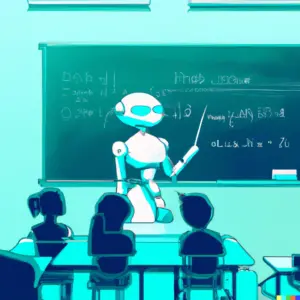
Combining Artificial Intelligence (AI) and Flipped Learning (FL) in higher education settings can lead to more personalized, engaging, and effective learning environments for both learners and instructors. The below content has been generated with the use of AI, exhibiting its potential in aiding in the teaching process:
- Personalized Learning Pathways
AI can analyze student performance data and tailor learning materials to meet individual needs. In a Flipped Learning setup, students engage with content (videos, readings, exercises) outside of class. AI tools can recommend content based on student progress, learning pace, and performance, ensuring that each learner focuses on areas where they need improvement.
- AI-Powered Content Delivery
AI can assist in delivering the flipped content. For example, AI tutors or chatbots can help explain concepts, answer students’ questions, or provide additional resources. Adaptive learning platforms can modify content complexity based on a student’s interaction, making it easier for them to grasp complex concepts at their own pace.
- Efficient Assessment and Feedback
AI tools can automatically assess quizzes, assignments, and even written or spoken language tasks, providing instant feedback. In Flipped Learning, students complete assignments outside of class, and AI-driven assessments allow them to learn from their mistakes in real time, preparing them for deeper in-class discussions.
- Enhanced In-Class Interaction
With the basic content covered outside of class, AI-driven analytics can provide instructors with insights into students’ comprehension and struggles. This allows teachers to focus in-class time on targeted discussions, group work, and interactive problem-solving based on real-time data.
- Language Learning and Practice
For language classrooms, AI tools like speech recognition and natural language processing (NLP) applications help students practice pronunciation, vocabulary, and grammar outside of class. In-class time can then focus on higher-level discussions and conversational practice, while AI provides consistent practice opportunities in a flipped format.
- Continuous Monitoring and Improvement
AI systems track student progress over time, identifying patterns and trends that may not be apparent to instructors. This data can inform future flipped lessons, helping teachers adjust content delivery, enhance flipped materials, and focus on areas where students face challenges.
- Automation of Administrative Tasks
AI can handle routine administrative tasks like grading, attendance tracking, and generating reports on student progress. This frees up instructors to spend more time on mentoring, facilitating in-class activities, and providing personalized support.
- Adaptive Collaboration and Group Work
AI can be used to form optimal study groups or project teams based on students’ performance data and collaboration styles. In a flipped classroom, where group work is often emphasized, AI helps ensure that students are matched effectively to maximize learning outcomes.
By combining AI with Flipped Learning, higher education classrooms can become more dynamic and student-centered, promoting active learning while utilizing technology to streamline and personalize the learning experience.
